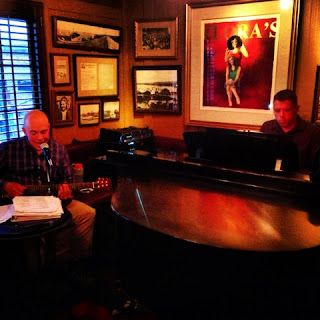 |
| Arriving at the Hamilton Ranch, immortalized by John Steinbeck in East of Eden |
One of the more fascinating concepts I studied in the wine industry was the French notion of terroir. In France (and most "old world" wine producing countries), wines are not named or labeled for their varietal (Chardonnay, Cabernet Sauvignon, Petit Verdot, etc.) but rather by their appellation, or place of origin. The French have a very rigorous wine, cheese, butter, and agricultural classification system designed and controlled by a government body (the AOC) that has, in some form, existed since the 15th century (insofar as wine is concerned). Per French law, all products within the purview of the AOC must be labeled in a way that identifies the region and commune of production. Beyond simple quality control, the AOC's mandate brought the notion of terroir into being. Terroir, simply put, is a "sense of place."
Over time, I learned how to differentiate between wines of certain soil typographies. The Sancerre and Pouilly-Fume wines of the Loire valley have a distinctly flinty, lemon-lime-citrus quality; the minerality and fruit character of this region's grapes are a direct link to the calcareous kimmeridgian limestone deposits of the valley floor. In other parts of the world, the same varietal (sauvignon blanc) exhibits tremendously different characteristics (different terroir). In New Zealand, the sauvignon blanc grape boasts aromas of freshly cut grass, grapefruit, and sometimes even cat pee (seriously!). In spite of being built from the same fundamental architecture, sauvignon blancs from South Africa, Chile, California, France, and New Zealand have surprisingly little in common. Acidity, flavor, aroma, appearance, viscosity, and alcohol content all vary tremendously. While a winemaker in the southern hemisphere might employ viticultural practices (pruning, harvesting, irrigation, trellising) identical to his favorite winemaker in the northern hemisphere, the terroir, the wines' expressive identity, will be noticeably different. In the same way, one might study the work of two literary contemporaries (Hemingway and Fitzgerald come to mind) and explore how terroir influenced their craft. For the past three weeks, we have been examining John Steinbeck's life in this way...
Each time I have visited estates and learned about soil typography and topography, I have felt more genuinely connected to the wines, their winemaker, and the vineyards. In the same vein, the more time I spend "in the land" of Steinbeck, the greater my love and appreciation for his work seems to become. There is a powerful sense of place here, and every location we visit sends out distinct "vibes;" warmth, love, uncertainty, loneliness, nostalgia, despair, and violence all contribute to establishing Steinbeck's central coast as a mosaic of human emotion.
Here we have a topographical map of the Hamilton homestead:
Our visit to the East of Eden ranch (Samuel Hamilton's) lent me a newfound (and downright visceral) appreciation for Steinbeck and his forebears. The relatively untouched quality of the ranch, especially the natural environment surrounding the homestead, screamed "Sam Hamilton." In fact, the windmill still bears the Hamilton moniker (look closely at the shot-up blade!):
|
Robert, the son of the current owner of the Hamilton ranch, showed us around the beautiful property (and sang us a personalized and heart-wrenching rendition of "Take Me Home, Country Roads" by John Denver). Clearly, the man loves his home, in spite of its obvious barrenness.
I cannot stress enough the authenticity of this experience... Robert's mother served us coffee and zucchini bread (which was beyond tasty) while he guided us through the remnants of the original Hamilton homestead (outlined in great detail in East of Eden):
 |
| The Hamilton homestead... |
Robert took us behind the scenes to see Samuel's actual anvil. Used extensively throughout East of Eden, the device embodies the industry, intelligence, and influence Sam held over the King City community. Absolutely amazing to see....
 |
| Samuel Hamilton's anvil |
 |
| Fossils! |
 |
| The road back to King City |
After leaving the East of Eden ranch, we stopped for a brief tour of the Santa Lucia Highlands' grape growing industry... picturesque and delicious!
Sunday night, Jim and I played a gig at The Sardine Factory, a piano bar on Cannery Row. Photo props to Mark (I totally thieved this picture off his blog: Mark's Blog ).
It was a genuinely fun night!
 |
| Jim and Dan live in the Can! (Photo props to Mark M.) |






No comments:
Post a Comment